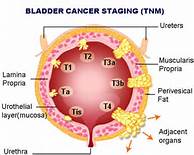
Bladder cancer is any of several types of cancer arising from the epithelial lining (i.e., the urothelium) of the urinary bladder.
Bladder cancer
Synonyms: Transitional cell carcinoma of the bladder; Urothelial cancer
This type of cancer starts in the bladder. Bladder is the part of the body that releases and holds urine. It is in the center of the lower abdomen.
Causes:
Symptoms:
Diagnosis:
Treatment: It depends on the stages of the cancer.
 Stage 0 and I treatments: Surgery to remove the tumor without removing the rest of the bladder. Immunotherapy or Chemotherapy placed directly into the bladder
Stage 0 and I treatments: Surgery to remove the tumor without removing the rest of the bladder. Immunotherapy or Chemotherapy placed directly into the bladder
 Stage II and III treatments: Surgery to remove the entire bladder (radical cystectomy) and nearby lymph nodes. Surgery to remove only part of the bladder, followed by radiation and chemotherapy. Chemotherapy to shrink the tumor before surgery.
Stage II and III treatments: Surgery to remove the entire bladder (radical cystectomy) and nearby lymph nodes. Surgery to remove only part of the bladder, followed by radiation and chemotherapy. Chemotherapy to shrink the tumor before surgery.
 A combination of chemotherapy and radiation (in people who choose not to have surgery or who cannot have surgery).
A combination of chemotherapy and radiation (in people who choose not to have surgery or who cannot have surgery).
CHEMOTHERAPY: Chemotherapy may be given to people with stage II and III disease either before or after surgery to help prevent the tumor from returning. For early disease (stages 0 and I), chemotherapy is usually given directly into the bladder. A Foley catheter can be used to deliver the medicine into the bladder. Common side effects include bladder wall irritation and pain when urinating. For more advanced stages (II-IV), chemotherapy is usually given by vein (intravenously).
IMMUNOTHERAPY: Bladder cancers are often treated with immunotherapy. In this treatment, a medicine triggers your immune system to attack and kill the cancer cells. Immunotherapy for bladder cancer is often performed using the Bacille Calmette-Guerin vaccine (commonly known as BCG).
SURGERY: Surgery for bladder cancer includes:
Transurethral resection of the bladder (TURB): Cancerous bladder tissue is removed through the urethra.
Partial or complete removal of the bladder: Many people with stage II or III bladder cancer may need to have their bladder removed (radical cystectomy). Sometimes, only part of the bladder is removed. Chemotherapy is usually given before or after this surgery.
Surgery may also be done to help your body drain urine after the bladder is removed. This may include:
Ileal conduit: A small urine reservoir is surgically created from a short piece of your small intestine. The ureters that drain urine from the kidneys are attached to 1 end of this piece. The other end is brought out through an opening in the skin (a stoma). The stoma allows the person to drain the collected urine out of the reservoir.
Continent urinary reservoir: A pouch to collect urine is created inside your body using a piece of your intestine. You will need to insert a tube into an opening in your skin (stoma) into this pouch to drain the urine.
Orthotropic neobladder: This surgery is becoming more common in people who have had their bladder removed. A part of your bowel is folded over to make a pouch that collects urine. It is attached to the place in the body where the urine normally empties from the bladder. This procedure allows you to maintain some normal urinary control.
Prognosis:
Possible Complications: Bladder cancers may spread into the nearby organs. They may also travel through the pelvic lymph nodes and spread to the lungs, liver, and bones. Additional complications of bladder cancer include:
Prevention: Quit smoke, Avoid exposure to chemicals linked to bladder cancer.
References:
Bladder cancer, cigarette smoking, chemical exposure, radiation therapy
references: